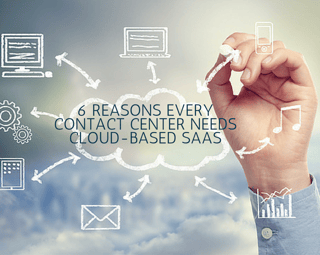 Upwards of 65% of businesses are currently using cloud-based platforms and, according to a study conducted in 2014, more than 21.1% of contact centers are planning to move their business to cloud-based platforms within the next 13-18 months.
Upwards of 65% of businesses are currently using cloud-based platforms and, according to a study conducted in 2014, more than 21.1% of contact centers are planning to move their business to cloud-based platforms within the next 13-18 months.
Cloud-based solutions can do everything from improving the productivity of agents to increasing reliance on self-serve data solutions. These benefits, along with many others, are the primary reasons that cloud solutions are becoming ever-more popular in the contact center sector.
Here are the top 6 reasons all contact centers should migrate to cloud solutions sooner rather than later:
1) Cost
The cost of software is a large consideration for any company, but for contact centers specifically. Contact centers vary hugely in size and output, which means that every contact center will need a slightly different platform to handle call volume.
Cloud-based SaaS solutions are generally structured in a pay-as-you-go format, which means that small contact centers won’t be burdened by huge fees and large contact centers can easily scale their financial commitment to the level of business they’re conducting. This helps allocate resources properly and ensures that every contact center has exactly the software it needs.
2) Software mobility
One of the largest challenges that contact centers face is the stationary nature of data. Traditionally, data has always been updated and stored in different applications, which requires managers to train agents on many different applications. This results in disconnection, mistakes, and incomplete answers to customer questions. With cloud-based SaaS, however, applications are easily accessed from any platform, which allows contact centers to better serve customers.
3) Ease of installation
Contact centers need to be agile enough to keep up with customer demands, but this agility can be easily interrupted by software that requires hours to install successfully on all of the center’s computers. Cloud-based software systems, though, are much quicker and can be successfully installed on every single one of a contact center’s computers quickly and efficiently. This allows contact centers to avoid disruptions in work and to ensure that customer service and agent productivity don’t suffer during software updates.
4) Streamlined data storage
It’s not productive or efficient for agents to cut and paste data between applications or to consistently “alt-tab” between various applications for a single call. With cloud-based applications, these inconveniences are a thing of the past.
Cloud-based solutions can integrate fully and intelligently with other cloud-based systems. This helps contact centers store all of their data in one convenient location. Additionally, cloud-based solutions allow contact centers to integrate data with other cloud applications for ease of accessibility and increased connection. This eliminates data entry duties and ensures that all software is linked for maximum collaboration and usability.
5) Seamless upgrades
By far one of the most attractive aspects of cloud-based SaaS is that the entire system is managed by the SaaS provider, rather than an on-site IT department. This means that when software updates are available, they roll out automatically. This allows contact centers to save the time and resources that would have been allocated to IT and use them, instead, to improve customer service and agent experience.
6) Centralization
With cloud-based solutions, companies can access the data they need in one convenient, centralized location. This means that customer information is available to everyone in a company, which allows agents to provide a more seamless and personalized experience to every customer they come into contact with.
When a contact center doesn’t have this centralized data construct, it’s inevitable that agents will eventually wind up on a call without the data they need to adequately complete it. Additionally, the introduction of a cloud-based SaaS means that managers can facilitate changes at multiple contact center locations without spending the time and resources that would be required to do it in person. In short, cloud-based solutions help to ensure consistency through centralization, which helps contact centers become more effective.
Conclusion
From adding new channels to reducing service costs and streamlining analytics, cloud-based solutions can offer many benefits to contact centers. Cloud applications have grown hugely in the last several years and SaaS revenue is projected to grow to $53.8 billion by 2018. This means that now is a good time to get involved in cloud-based solutions and that contact centers who do are simply joining an established and well-defined communications trend.
From making contact center communications more seamless to improving data storage options, the benefits of adopting cloud-based SaaS are numerous and well-defined. To learn more about how cloud-based SaaS can benefit your specific contact center, contact Spice CSM today. We can help you determine which cloud-based solutions are right for you and help get your contact center functioning more intuitively in no time.


